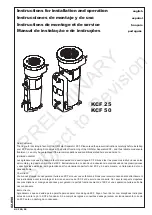
19
GB
Specifications
Voltage: 120V ~ Single Phase
Minimum Branch Circuit Requirement:
15 Amp
Fuse Type:
Time Delay
Air Tank Capacity:
15 L (4 gallons)
Approximate Cut-in Pressure:
110 PSI (7,5 bar)
Approximate Cut-out Pressure:
135 PSI (9,3 bar)
SCFM @ 40 PSI:
3.6
SCFM @ 90 PSI:
2.5
Weight:
34 lbs. (15.4 kg)
Glossary
Become familiar with these terms before
operating the unit.
CFM:
Cubic feet per minute.
SCFM:
Standard cubic feet per minute; a unit
of measure of air delivery.
PSIG:
Pounds per square inch gauge; a unit
of measure of pressure.
Code Certifi cation: Products that bear one
or more of the following marks: UL, CUL,
ETL, CETL, have been evaluated by OSHA
certifi ed independent safety laboratories and
meet the applicable Underwriters Laborato-
ries Standards for Safety.
kPa (kilopascal):
Metric pressure measure-
ment. 1 kilopascal equal 1000 pascals.
Cut-In Pressure:
While the motor is off,
air tank pressure drops as you continue to
use your accessory. When the tank pres-
sure drops to a certain low level the motor
will restart automatically. The low pressure
at which the motor automatically restarts is
called "cut-in" pressure.
Cut-Out Pressure:
When an air compressor
is turned on and begins to run, air pressure
in the air tank begins to build. It builds to a
certain high pressure before the motor auto-
matically shuts off, protecting your air tank
from pressure higher than its capacity. The
high pressure at which the motor shuts off is
called "cut-out" pressure.
Branch Circuit:
Circuit carrying electricity
from electrical panel to outlet.
Duty Cycle
This air compressor pump is capable of
running continuously. However, to prolong the
life of your air compressor, it is recommended
that a 50%-75% average duty cycle be
maintained; that is, the air compressor pump
should not run more than 30-45 minutes in
any given hour.
Safety Guidelines - Definitions
This manual contains information that is
important for you to know and understand.
This information relates to protecting
YOUR
SAFETY
and
PREVENTING EQUIPMENT
PROBLEMS
. To help you recognize this
information, we use the symbols below.
Please read the manual and pay attention to
these symbols.
DANGER
. Indicates an imminently
hazardous situation which, if not avoided,
will
result in
death or serious injury
.
WARNING.
Indicates a potentially
hazardous situation which, if not avoided,
could
result in
death or serious injury.
CAUTION.
Indicates a potentially
hazardous situation which, if not avoided,
may
result in
minor or moderate injury.
CAUTION.
Used without the safety alert symbol
indicates a potentially hazardous situation
which, if not avoided,
may
result in
property
damage
.
General Safety Instructions
WARNING. Some dust created by power
sanding, sawing, grinding, drilling, and other
construction activities contains chemicals
known (to the State of California) to cause
cancer, birth defects or other reproductive
harm. Some example of these chemicals are:
•
lead from lead-based paints
•
crystalline silica from bricks and
cement and other masonry products
•
arsenic and chromium from
chemically-treated lumber
Your risk from these exposures varies,
depending on how often you do this type
of work. To reduce your exposure to these
chemicals: work in a well ventilated area,
and work with approved safety equipment,
al ways wear OSHA/MSHA/NIOSH
approved, properly fi t ting face mask or res-
pi ra tor when us ing such tools.
When using air tools, basic safety
precautions should always be followed to
reduce the risk of personal injury.
DESCRIPTION, SPECIFICATIONS
AND INSTRUCTIONS
















































